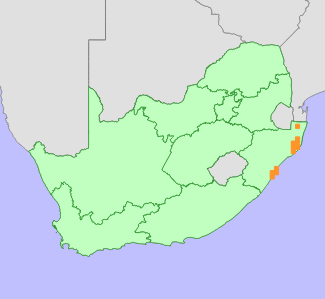|
Scientific Name | Pavonia dregei Garcke |
Higher Classification | Dicotyledons |
Family | MALVACEAE |
Synonyms | Pavonia microphylla E.Mey. ex Harv. |
National Status |
Status and Criteria | Vulnerable B1ab(iii) |
Assessment Date | 2017/10/02 |
Assessor(s) | L. von Staden |
Justification | Pavonia dregei is a range-restricted, but poorly known species, with an extent of occurrence (EOO) of 11 129 km². It is currently known from fewer than 10 remaining locations, and continues to decline due to ongoing habitat loss and degradation outside of protected areas. It is therefore listed as Vulnerable under criterion B. |
Distribution |
Endemism | South African endemic |
Provincial distribution | KwaZulu-Natal |
Range | This species is endemic to South Africa, and is found in the KwaZulu-Natal coast from Maputaland to Illovo. |
Habitat and Ecology |
Major system | Terrestrial |
Major habitats | Tembe Sandy Bushveld, Sand Forest, Northern Coastal Forest, KwaZulu-Natal Coastal Belt Grassland, Maputaland Coastal Belt |
Description | It occurs in coastal grasslands along forest margins, sometimes in disturbed places. |
Threats |
| Pavonia dregei is threatened in the southern parts of its range due to severe past and ongoing habitat loss to urban expansion, industrial development and coastal development. It was last recorded in the Durban area in the 1960s. It may still persist on The Bluff, but field surveys are needed to confirm this. Further north, coastal grasslands have been extensively converted to sugarcane plantations, and very little habitat remains outside protected areas. This species is now suspected to be locally extinct around Mtubatuba due to habitat loss to agriculture. In Maputaland it is threatened by habitat loss to expanding rural settlements, but several subpopulations occur within protected areas where they are safe from threat. |
Population |
This species is known historically from a wide area along the KwaZulu-Natal coast, but recent records are scarce. It is common in the Hluhluwe game reserve, but its abundance elsewhere is not known. It is possibly somewhat resilient to disturbance, but it is likely to have declined due to habitat loss. Field surveys are needed to determine whether any subpopulations survive south of Empangeni.
|
Population trend | Decreasing |
Assessment History |
Taxon assessed |
Status and Criteria |
Citation/Red List version | | Pavonia dregei Garcke | VU B1ab(iii) | 2020.1 | | Pavonia dregei Garcke | Least Concern | Raimondo et al. (2009) | |
Bibliography |
Garcke, A. 1881. Ueber die Gattung Pavonia. Jahrbuch des Ko?niglichen Botanischen Gartens und des Botanischen Museums zu Berlin 1:198-223.
Harvey, W.H. 1859. Malvaceae. In: W.H. Harvey and O.W. Sonder (eds). Flora Capensis I (Ranunculaceae-Connaraceae):157-177. Hodges, Smith and Co., Dublin.
Raimondo, D., von Staden, L., Foden, W., Victor, J.E., Helme, N.A., Turner, R.C., Kamundi, D.A. and Manyama, P.A. 2009. Red List of South African Plants. Strelitzia 25. South African National Biodiversity Institute, Pretoria.
|
Citation |
| von Staden, L. 2017. Pavonia dregei Garcke. National Assessment: Red List of South African Plants version 2024.1. Accessed on 2025/11/18 |
 Comment on this assessment
Comment on this assessment


